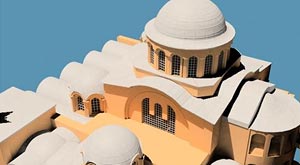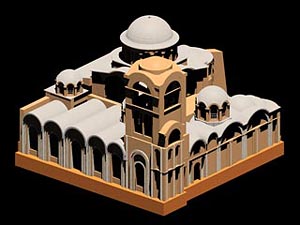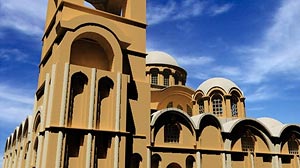 |
|||||
| History | Images | Virtual Reality | 3-D Animations | Iconography | ||||||
|
||||||||||||||||||||||
|
||||||||||||||||||||||
| 3-D Animations Phase I: Sixth Century According to the fourteenth-century historian Nicephoros Gregoras, the first church on the site (a basilica) was presumably built in the sixth century by a certain Theodore, relative of empress Theodora. The only trace from this phase of building is a wall arcade at the eastern end of the church. No reconstruction is possible. Phase II: Post Sixth-Century Construction The crown of the south arch of the sixth-century wall arcade collapsed and was rebuilt. Two tomb chambers underneath the naos seem to belong to this phase. Phase III: The first Comnenian Church (1077–1081) A new church is built by the mother-in-law of Emperor Alexios, the Bulgarian Maria Dukaina. This church was most likely of the so-called cross-in-square type, common in Constantinople since the late ninth-early tenth centuries. The ground plan probably resembled the church of Christ Pantepoptes in Istanbul Phase IV: The second Comnenian Church (ca. 1120) The church is rebuilt (after collapse during an earthquake?) under the Sebastokrator Isaak Komnenos. While using some of the walls of the earlier church, the eastern apse was completely rebuilt, the four column support removed and the dome enlarged over a wider naos. Massive masonry piers were added in the corners of the naos during this period. The church probably featured a narthex topped by twin domes. A chapel (of uncertain shape) existed on the south side of the church. Phase V: The church of Theodore Metochites (1316–1321) Metochites utilized the supports and eastern apse of the previous church, but rebuilt the Pastophoria (rooms on either side of the apse). He added new rooms on essentially all sides of the church: two narthices, a parekklesion (or funerary church) on the south that communicates with both the inner and outer narthices and a two-storied north compartment that is said to have functioned as a library. The interior decoration of the church is entirely the result of Theodore Metochites's patronage. This segment of the "Restoring Byzantium" Web site draws on Macromedia Flash and Apple QuickTime technologies. Download the latest versions of these plug-in for optimal viewing. Transitions between Phases of Construction 3-D animation of transition from belltower to minaret QuickTime Animation 1 | QuickTime Animation 2 3-D animation of transition from arched to flat roof QuickTime Animation 1 3-D animation of transition from open to closed arcades QuickTime Animation 1 Modeling of Phases of Construction 3-D animation of Kariye Camii with arched roof, open arcades, and bell tower QuickTime Animation 1 3-D animation of Kariye Camii with arched roof, closed arcades, and bell tower Flash Animation 1 | Flash Animation 2 3-D animation of Kariye Camii with arched roof, closed aracades, and minaret QuickTime Animation 1 3-D animation of Kariye Camii with flat roof, closed arcades, and minaret QuickTime Animation 1 3-D aerial animation of Kariye Camii with arched roof and minaret Flash Animation 1 | Flash Animation 2 |
 Turkey, Istanbul (Constantinople), Kariye Camii, Model.  Turkey, Istanbul (Constantinople), Kariye Camii, Model.  Turkey, Istanbul (Constantinople), Kariye Camii, Model. |
||||||